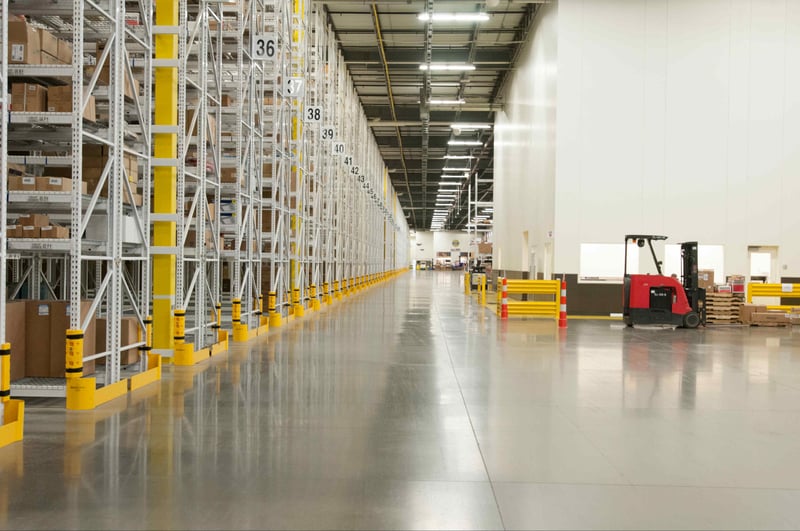
The winter months may be the toughest time of the year for floors. To see why hard-surface floors take such a beating during the winter months, all you need to do is look outside in most areas of the country. Winter is typically when we have the most rain, snow, and ice buildup. In addition, this is also the time of year ice melt and other salt-based products are used to keep walkways and entries safe for foot traffic. Rain, snow, ice, and ice melt can play havoc on a floor's finish, and when this happens, they can also damage the floor itself. This is because the role of a floor finish is not to just put a shine on the floor, which is the result of the application, but to actually protect the floor from moisture, soils, contaminants, etc.
But there are ways to keep hard-surface floors clean, safe, and healthy during the winter. This is especially true if a durable floor finish has already been applied. It all comes down to three key things:
- Installing effective mattings systems (entry mats).
- Dust and damp mopping or using an automatic scrubber.
- Burnishing or polishing on a regular basis.
Matting
Entry and walkway mats are often viewed as an afterthought in many facilities. However, in order for a facility to be LEED* certified, it must have an effective entryway matting system in place. Mats are required because they have proved their effectiveness at keeping soil and moisture on shoe bottoms from being walked into a facility. However, placing a mat here and a mat there is not an effective strategy. According to Adam Strizzi, Marketing Manager for Crown Matting Technologies, three types of mats should be installed at all key building entries, especially those in industrial locations.
The three mat types are the following:
Scraper mats. These mats, as the name implies, scrape larger soils off of shoe bottoms. They are placed outside of entries.
Wiper/scraper mats. Many facilities have a vestibule area directly inside their entries. This is a perfect place for a wiper/scraper mat; however, it can also be installed directly inside a facility. This mat is designed to remove more of the larger soils as well as smaller soils and moisture.
Wiper mats. Often called the final line of defense, the wiper mat further wipes shoe bottoms clean and removes moisture.
"The length of the mat is also very important," adds Strizzi. "We refer to this as the 'Rule of 15s,' and it means that each of the three types of mats is five feet long, totaling 15 feet. LEED suggests 10 feet of matting is required, but 15 feet helps ensure that as much as 70 percent to 80 percent of all soil and moisture are removed from shoe bottoms."**
Cleaning
Floors must be swept or dust mopped regularly – possibly multiple times a day in an industrial location – as well as damp mopped. This is especially true during the winter months, according to Sean Martschinke, a CIMS ISSA Certification Expert (I.C.E.) and Product Manager for Tornado Industries, a manufacturer of professional floorcare equipment. But there are two problems with mopping floors that we must be aware of.
"First, many industrial locations are simply too large to damp mop a floor," says Martschinke. "If the custodial crew is taking two or more hours to damp mop a floor, administrators should consider selecting an automatic scrubber for this job."
The second issue is problems with the methodology itself. As the mop is used, especially in an industrial location, it becomes more and more soiled, as does the cleaning solution. "With soiling, the mop can begin to spread contaminants instead of removing them," explains Martschinke. "Further, as soiling builds up in the cleaning solution, the chemical agents can begin to lose their effectiveness, both of which defeat the whole purpose of cleaning and mopping floors."
Because of this, industrial facility administrators should consider using an automatic scrubber to clean industrial floor space. A fully automatic floor scrubber is designed to apply cleaning solution to the floor, agitate or scrub it, strip it (when called for), wet-vacuum it, and then squeegee it dry, all automatically and all in one pass. "It is the agitation, along with the cleaning chemicals used, that loosens and helps remove soils," according to Martschinke. "The end result is that floors are much cleaner than those cleaned using traditional methods and are relatively dry [quickly], allowing immediate access and protecting building occupant safety."
As to speed, according to a study by the University of Minnesota, an auto scrubber "can reduce the time it takes one person to clean 5,000 square feet with a mop and bucket from one to two hours down to 15 to 30 minutes." This time reduction also translates into dollars and cents. Paying a custodial worker for two hours of work that can be completed in 15 to 30 minutes with an automatic scrubber means the worker has time to clean other areas of the facility, which also means that fewer cleaning workers may be needed.
Burnishing or Polishing Regularly
The final step in winter floorcare is regular burnishing or polishing. And there is a difference. If a high-speed floor finish has been applied to the floor, then it should be burnished with a high-speed machine delivering 1,200 or more rpm (rotations per minute). If a traditional finish has been applied, then a buffer or traditional floor machine should be used. These machines typically generate 175 to 350 rpms. Using a burnisher on a floor where a traditional finish has been applied will likely remove the finish.
However, burnishing or polishing floors on a regular basis is very important because it helps restore the floor's shine, can help enhance slip resistance, and removes heel marks as well as any soils remaining on the floor after auto scrubbing.
"These three steps – installing mats, damp [mopping] or auto scrubbing, and burnishing – are key to a winter floorcare strategy," adds Martschinke. "They help keep floors looking and performing their best in wintertime and throughout the year."
Robert Kravitz is a frequent writer for professionals within the cleaning and building industries.
* Leadership in Energy and Environmental Design
** LEED 2009 requires entryway matting systems need to be at least 10 feet long. New in LEED v4 certification, mats also must be cleaned weekly. Typically this involves vacuuming, replacing if the mat becomes saturated with soil or moisture, or extracting with a professional carpet extractor.
This article was written by Robert Kravitz from Industrial Maintenance & Plant Operation and was legally licensed through the NewsCred publisher network. Please direct all licensing questions to legal@newscred.com.
CenterPoint Group provides discounts to key suppliers such as Office Depot, Enterprise and National Car Rental, Travel Leaders Corporate, W.W. Grainger, Verizon Wireless and more
The information contained in this article is intended for general information purposes only and is based on information available as of the initial date of publication. No representation is made that the information or references are complete or remain current. This article is not a substitute for review of current applicable government regulations, industry standards, or other standards specific to your business and/or activities and should not be construed as legal advice or opinion. Readers with specific questions should refer to the applicable standards or consult with an attorney.








Leave a Reply
Comment policy: We love comments and appreciate the time that readers spend to share ideas and give feedback. However, all comments are manually moderated and those deemed to be spam or solely promotional will be deleted.